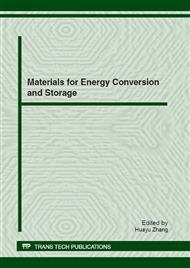p.232
p.236
p.240
p.244
p.248
p.252
p.256
p.261
p.265
Preparation and Properties of TiO2/Ti Catalysts by Ionic Liquid Assisted Anodic Oxidation Method
Abstract:
Nano-titanium dioxide photocatalyst were prepared under anodizing in the ionic liquid [Bmim ]BF4, with the Sulfuric acid and water as solvent, groped for the amount of ionic liquid doping in electrolyte. With the help of XRD and SEM technology we characterized the light catalyst that we have prepared. By oxidation degrading LuoDanMing B, we tested its light catalytic activity. The results show that: the best current up time using anodic oxidation method for the preparation of TiO2/Ti catalyst is 10 min, while the light catalytic activity of the catalyst is the best; the best doping quantity of ionic liquid in electrolyte is 0.5 mL, while the light catalytic activity of the catalyst is the best; in the membrane of the titanium dioxide crystals both Rutile and Anatase are more; the mixed effect of Rutile and Anatase is better. Besides, the membrane surface is rough and porous. Therefore, the catalytic activity is higher.
Info:
Periodical:
Pages:
248-251
Citation:
Online since:
July 2012
Authors:
Price:
Сopyright:
© 2012 Trans Tech Publications Ltd. All Rights Reserved
Share:
Citation:


